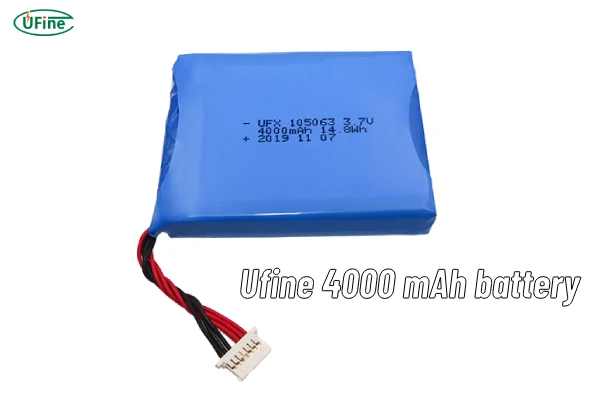When you rely on a device to get through your day, a dependable battery is non-negotiable. Whether it’s powering your smartphone, tablet, or even a drone, the 4000 mAh battery has become a popular power source for modern tech users. With its balance of capacity, longevity, and versatility, it’s no wonder people turn to this battery for reliable performance.
In this comprehensive guide, we’ll explore the 4000 mAh battery from every angle: its types, voltage, common shapes, and how to interpret markings like “S” and “P.” We’ll also break down its pricing, lifespan, and tips for maximizing its efficiency. Understanding these features will empower you to make informed decisions about which battery best suits your needs.
Part 1. Types of 4000 mAh batteries
The capacity rating of 4000 mAh applies to multiple battery types, each with distinct chemical properties that make them suited for different purposes. Here’s a breakdown of the most common types you’ll encounter:
-
Lithium-Ion (Li-ion): Lithium-ion batteries are among the most widely used in consumer electronics. Known for their high energy density, these batteries store a significant amount of power without adding extra weight, making them ideal for smartphones, laptops, and digital cameras. Their long cycle life and rechargeable nature make them practical for frequent, daily use.
-
Lithium Polymer (LiPo): LiPo batteries are similar to Li-ion but come with a few key differences. They’re flexible, which allows for various shapes and sizes, and they tend to be lighter than Li-ion cells. This makes them popular in applications like drones, tablets, and ultra-thin laptops. LiPo batteries offer stable, efficient power but can be a bit more sensitive to physical damage, which can lead to overheating if not carefully handled.
-
Nickel-Metal Hydride (NiMH): While NiMH batteries aren’t as lightweight or high-capacity as lithium-based batteries, they’re known for durability and affordability. They’re commonly used in devices like flashlights, portable fans, and game controllers, where a 4000 mAh rating is well-suited for moderate to heavy usage.
-
Lithium Iron Phosphate (LiFePO4): These batteries stand out for their stability and safety, offering a longer lifespan than other types. They’re popular in industrial applications, electric vehicles, and some solar power setups. While they’re heavier than Li-ion or LiPo, their durability makes them ideal for situations requiring frequent, dependable recharging.
Each of these battery types brings its own strengths to the table, so the right one for you will depend on what your device demands in terms of energy density, weight, and recharging needs.
Part 2. Voltage
When considering a 4000 mAh battery, voltage is a key factor because it dictates compatibility with various devices. Here’s how common voltages affect battery use:
-
3.7V: This voltage is typical in single-cell Li-ion and LiPo batteries. A 4000 mAh, 3.7V battery is frequently used in portable electronics, from smartphones to Bluetooth speakers, providing ample power for hours of use.
-
7.4V: Batteries at this voltage are usually found in dual-cell configurations, commonly seen in remote-controlled vehicles, drones, and higher-powered devices like DSLR cameras. They offer a step up in power and are typically used where devices require a bit more kick to function efficiently.
-
12V: While less common, 12V 4000 mAh batteries can be seen in specialty applications such as portable medical devices or backup systems. These batteries are often used in devices where a steady and slightly higher power output is essential.
Part 3. Shapes
The physical shape and configuration of a 4000 mAh battery are important considerations as they determine the battery’s compatibility with specific devices:
-
Cylindrical Cells: Found mainly in Li-ion and NiMH types, cylindrical 4000 mAh batteries are used in power tools, flashlights, and some medical equipment. Their robust design provides physical protection and makes them suitable for heavy-duty applications.
-
Pouch or Prismatic Cells: Commonly seen in LiPo batteries, this shape allows for thin, flexible designs and is ideal for compact, portable devices like tablets, drones, and even some smartphones. These batteries maximize space efficiency and are generally lightweight.
-
Rectangular or Block Cells: Some 4000 mAh batteries, especially LiFePO4 or specialized Li-ion cells, are shaped to fit specific industrial equipment or backup power systems. Their design maximizes stability and power output in environments where reliability is critical.
Part 4. What do “S” and “P” mean on a 4000 mAh battery?
Understanding the “S” and “P” markings on a 4000 mAh battery can help you decode how it’s configured:
-
“S” (Series): The “S” marking refers to how many cells are connected in series, which increases the battery’s voltage. For example, a 3S configuration means three cells in series, so each cell’s voltage is added up to reach a higher total.
-
“P” (Parallel): The “P” marking indicates cells connected in parallel, which increases the capacity (mAh) but keeps the voltage the same. A 2P configuration means two cells in parallel, doubling the capacity for longer usage time.
Part 5. Price
The price of a 4000 mAh battery varies widely based on factors like:
- Battery Type: Lithium-ion batteries generally cost more than NiMH but provide longer lifespan and higher energy density.
- Brand and Quality: Well-known brands with rigorous quality testing are typically more expensive.
- Special Features: Batteries with safety features like overcharge protection or thermal management systems often come with a premium price tag.
Prices range from $10 to $50, depending on these factors and specific use cases.
Part 6. How long does a 4000 mAh battery last?
A 4000 mAh battery’s lifespan depends on its usage, but typically, it can power a smartphone for 8-12 hours of moderate usage or a Bluetooth speaker for up to 12 hours. In high-demand devices like drones or power tools, it may only last a couple of hours.
Part 7. How to calculate battery life?
To estimate a 4000 mAh battery’s runtime, use this formula:
For example, a device drawing 500 mA will last approximately 8 hours on a 4000 mAh battery (4000 mAh ÷ 500 mA).
Part 8. Is a higher battery capacity better?
While a higher capacity means longer runtime, it isn’t always better. Higher-capacity batteries are larger, heavier, and may not fit all devices. Also, a high-capacity battery in a device that doesn’t need it could lead to unnecessary weight and size, making it inefficient.
Part 9. Final words
When choosing a 4000 mAh battery, consider its chemistry, shape, voltage, and intended application. A lithium-ion or lithium polymer battery will provide compact power for small devices, while NiMH or LiFePO4 types are suited for more demanding or industrial applications.
If you’re looking for a reliable and customizable option, Ufine Battery offers a range of 4000 mAh batteries tailored to specific needs. They provide high-quality Li-ion, LiPo, and LiFePO4 batteries, allowing you to choose a model that perfectly fits your device.
Related Tags:
More Articles

White Stuff on Battery Terminals: A Step-by-Step Cleaning and Maintenance Guide
White stuff on battery terminals is corrosion. Learn how to clean it safely, prevent damage, and keep your battery running strong with simple steps.
Understanding How Glass Mat Batteries Work: Technology, Benefits, and Limitations
Glass mat batteries power cars, RVs, and solar systems. Learn how they work, their benefits, and what to consider before choosing one.
A Buyer’s Guide for AA Size Lithium Battery
Discover the power of AA size lithium batteries—types, voltage, capacity, and more! Learn how to choose the best one for your needs. Read now!
Li-Ion Battery Prices – Where to Buy Cheap & Safe
Discover li-ion cell prices, key market factors, and how to find affordable custom batteries from top suppliers like Ufine Battery.
How Long Does a 2200mAh Battery Last?
Discover everything about 2200mAh batteries—types, charging time, lifespan, and whether it’s enough for your device.






